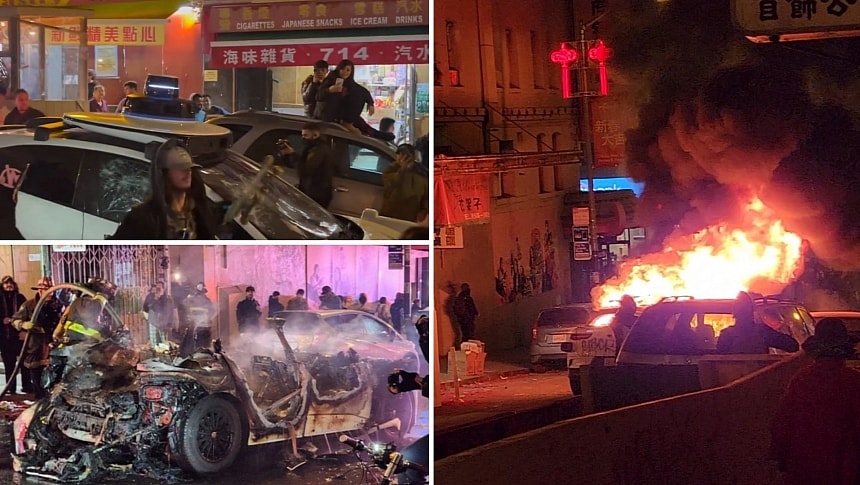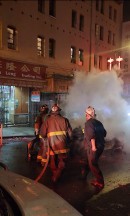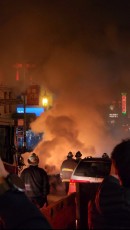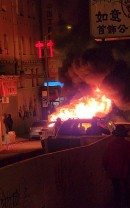A Waymo driverless car was set on fire in San Francisco Chinatown after people blocked its way, broke the windows, and set off fireworks inside the vehicle. This was the most serious incident involving a robotaxi after previous instances showed them being coned and vandalized. It could also be a sign of the times as robots become more common.
Autonomous driving is one of those great technologies promising to solve many problems for people who can't or don't want to drive a car anymore. Although they could be the first to benefit from a driverless car, the advantages of truly autonomous vehicles are more important than convenience. Autonomous driving promises to make the roads safer by eliminating human error. It could also vastly optimize personal mobility, as one robotaxi could be used more efficiently, 24 hours per day, instead of collecting dust in the garage most of the time.
However, the state of technology doesn't give us much hope that humans behind the steering wheel will soon become a thing of the past. Many companies are working on driverless cars, yet very few have made notable progress, and they are all controversial. Tesla promised to bring the benefits of self-driving cars to all its electric vehicles. However, the progress is only visible to a handful of die-hard fans.
Other companies, like Google's Waymo and GM's Cruise, have focused on offering driverless ride-hailing services in selected cities. Although not entirely painless, these pilot programs have gradually expanded from certain areas of San Francisco to the whole town and even other cities. Although these companies bragged about the safety of their robotaxis, both have been involved in controversial accidents over time. Cruise is still trying to recover from one after one of its cars rolled over a pedestrian in San Francisco.
Even without high-profile crashes, many have perceived robotaxis as a nuisance for local traffic. In many incidents, robotaxis have blocked the streets, tampered with police scenes, and hindered emergency services' response. This has led to the emergence of activist movements trying to stop robotaxi deployment, especially in San Francisco. The protest started small, with people disabling the robotaxis by placing traffic cones on their hoods. This activity is now known as "coning" and has become a common pastime for SF teens.
It wasn't long before activism turned into vandalism, as seen in several incidents. Last July, a group of skateboarders vandalized a Waymo vehicle during a local event. Two months later, a masked man tried to destroy a Cruise autonomous vehicle with a hammer. Although things appeared to have cooled down for a while, a new incident showed that robots are not welcome on the streets of San Francisco.
Video shared on social media shows people vandalizing a Waymo driverless vehicle on Jackson Street in San Francisco during the Lunar New Year celebrations. The poor Jaguar I-Pace stood no chance against the angry mob that blocked and vandalized it. Somebody jumped on the car's hood and broke the windshield and side windows using a skateboard. Others graffitied the vehicle, but the situation quickly escalated when someone lit fireworks under it. Nothing happened except a loud bang, so the crowd set fireworks inside the car instead. Soon, the robotaxi was ablaze, and firefighters arrived minutes later.
Thankfully, no passengers were inside the vehicle during the incident. As a Waymo spokesperson confirmed, the car had just completed a drop-off when it was vandalized. I'm unsure if things would've been different had a driver been in the car. In the July incident, the safety driver in the car did not prevent the skateboarders from vandalizing the Waymo vehicle.
However, the state of technology doesn't give us much hope that humans behind the steering wheel will soon become a thing of the past. Many companies are working on driverless cars, yet very few have made notable progress, and they are all controversial. Tesla promised to bring the benefits of self-driving cars to all its electric vehicles. However, the progress is only visible to a handful of die-hard fans.
Other companies, like Google's Waymo and GM's Cruise, have focused on offering driverless ride-hailing services in selected cities. Although not entirely painless, these pilot programs have gradually expanded from certain areas of San Francisco to the whole town and even other cities. Although these companies bragged about the safety of their robotaxis, both have been involved in controversial accidents over time. Cruise is still trying to recover from one after one of its cars rolled over a pedestrian in San Francisco.
Even without high-profile crashes, many have perceived robotaxis as a nuisance for local traffic. In many incidents, robotaxis have blocked the streets, tampered with police scenes, and hindered emergency services' response. This has led to the emergence of activist movements trying to stop robotaxi deployment, especially in San Francisco. The protest started small, with people disabling the robotaxis by placing traffic cones on their hoods. This activity is now known as "coning" and has become a common pastime for SF teens.
It wasn't long before activism turned into vandalism, as seen in several incidents. Last July, a group of skateboarders vandalized a Waymo vehicle during a local event. Two months later, a masked man tried to destroy a Cruise autonomous vehicle with a hammer. Although things appeared to have cooled down for a while, a new incident showed that robots are not welcome on the streets of San Francisco.
Video shared on social media shows people vandalizing a Waymo driverless vehicle on Jackson Street in San Francisco during the Lunar New Year celebrations. The poor Jaguar I-Pace stood no chance against the angry mob that blocked and vandalized it. Somebody jumped on the car's hood and broke the windshield and side windows using a skateboard. Others graffitied the vehicle, but the situation quickly escalated when someone lit fireworks under it. Nothing happened except a loud bang, so the crowd set fireworks inside the car instead. Soon, the robotaxi was ablaze, and firefighters arrived minutes later.
Thankfully, no passengers were inside the vehicle during the incident. As a Waymo spokesperson confirmed, the car had just completed a drop-off when it was vandalized. I'm unsure if things would've been different had a driver been in the car. In the July incident, the safety driver in the car did not prevent the skateboarders from vandalizing the Waymo vehicle.
happening NOW in SF. Waymo car vandalized & lit on fire @sfchronicle pic.twitter.com/OEZYFiy6mv
— Michael Vandi (@michael_vandi) February 11, 2024
Waymo Vehicle surrounded and then graffiti’d, windows were broken, and firework lit on fire inside the vehicle which ultimately caught the entire vehicle on fire. #SFFD
— SAN FRANCISCO FIRE DEPARTMENT MEDIA (@SFFDPIO) February 11, 2024
Photos by Séraphine Hossenlopp pic.twitter.com/aOTqL3Rk8V








